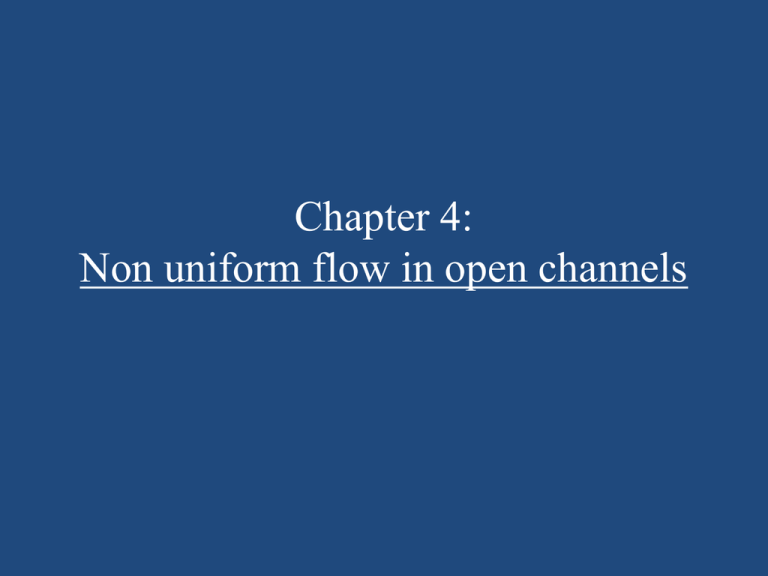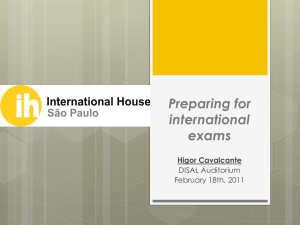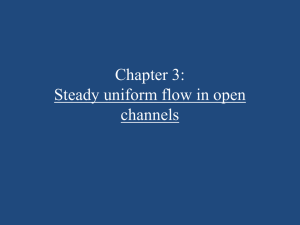Chapter 4 -Non uniform flow in open channels
advertisement

Chapter 4: Non uniform flow in open channels Learning outcomes • By the end of this lesson, students should be able to: – Relate the concept of specific energy and momentum equations in the effect of change in bed level - Broad Crested Weir – Relate the concept of specific energy and momentum equations in the effect of lateral contraction of channel ( Venturi Flume) UiTMKS/ FCE/ BCBidaun/ ECW301 2 Introduction • Analysis of steady non uniform flow in open channels. • Non uniform flow occurs in transitions where there is change in cross section or obstruction in channel. • Analysis requires a different approach, requiring the use of the energy equation in a different form. UiTMKS/ FCE/ BCBidaun/ ECW301 3 Specific energy & alternative depths of flow • Specific energy, E, v2 E D 2g (16.1) • For a wide rectangular channel, mean velocity is, Q Q q v A BD D • While the volume rate of flow per unit width, Q q B UiTMKS/ FCE/ BCBidaun/ ECW301 4 • Substituting v & q into E, q2 E D 2 gD2 q2 D ED 0 2g 3 2 (16.2) (16.3) • This equation has 3 roots: – 1 root is negative & unreal – 2 roots are positive & real, which give 2 alternate depths: • Larger depth: deep slow flow (subcritical/ tranquil/ streaming flow). • Smaller depth: shallow fast flow (supercritical/ shooting flow) UiTMKS/ FCE/ BCBidaun/ ECW301 5 UiTMKS/ FCE/ BCBidaun/ ECW301 6 UiTMKS/ FCE/ BCBidaun/ ECW301 7 • Critical depth, DC: – Depth at which the 2 roots coincide – q = qmax – E = Emin • To find DC: dE 2q 2 dD 1 2 gD3 • When dE/dD = 0, q Criticaldepth,DC g 2 1 3 Q 2 gB UiTMKS/ FCE/ BCBidaun/ ECW301 2 1 3 (16.4) 8 • Sub. q 2 gDC 3 from (16.4) to (16.2), 3 gDC 3 E DC DC 3 2 2 gDC DC 2 E 3 • Therefore, for rectangular channel, • Differentiating (16.3) & assuming E is constant q D2 g E D 1 2 1 D 1 dq 2 2 g E D 2 1 dD E D 2 UiTMKS/ FCE/ BCBidaun/ ECW301 (16.5) 9 • When becomes, D DC , qmax dq 1 0, E DC DC 0 dD 2 2 2 E 2 g E E 3 3 • Or qmax gDC 3 1 2 , (16.5) 2 2 g E 3 1 3 2 (16.6) UiTMKS/ FCE/ BCBidaun/ ECW301 10 • Critical velocity: velocity corresponding to critical depth. • Sub. E 3 2 D , D D into (16.1), C of flow C 2 v 3 DC DC C 2 2g vC gDC UiTMKS/ FCE/ BCBidaun/ ECW301 11 DC for non rectangular sections UiTMKS/ FCE/ BCBidaun/ ECW301 12 • For any shape and cross sectional area the E for any D, v2 E D 2g • Since v = Q/A, Q2 E D 2 2A g (16.7) • For flow at DC and vC, Emin, differentiating (16.7), (16.8) 2Q 2 A3 dA 1 2g dD 0 • But a change in depth will produce a change in cross-sectional area, therefore dA/dD=B. Q2 B 1 3 Ag UiTMKS/ FCE/ BCBidaun/ ECW301 (16.9) 14 • For critical flow, Q Ag vC A B 1 2 • From (16.9) vC g D (16.10) where D is the average depth. UiTMKS/ FCE/ BCBidaun/ ECW301 15 Froude Number • Assume a surface wave of height δZ is propagated from left to right of observer. • Wave is brought to rest relative to observer by imposing a velocity c equal to wave velocity on the observer, flow will appear steady. Mass per unit time(left of wave) Mass per unit time(right of wave) BZ Z u u c B Z u u c Zu uZ Zu cZ 0 c u Z Z Z u (5.32) Hydrostatic forcedue toZ Mass per unit time Change of velocity gZBZ BZu - c u gZ u c u UiTMKS/ FCE/ BCBidaun/ ECW301 17 • Sub. δu to (5.32), c u Z gZ Z Z c u c u 2 Z Z g gZ • If wave height δZ is small, Velocityof thepropationof the wave relativeto thefluid c - u gZ UiTMKS/ FCE/ BCBidaun/ ECW301 18 • Ratio of the stream velocity u to the propagation velocity c-u is known as Froude Number Fr. u u (5.34) Fr c u gZ • Fr can be used to determine the type of flow for open channel. UiTMKS/ FCE/ BCBidaun/ ECW301 19 • For critical flow conditions, the Froude Number is, Fr v gD vC 1 gDC – If v < vc – subcritical flow – If v > vc – supercritical flow • Important difference, – Subcritical : disturbances can travel upstream and downstream thus enabling downstream conditions to determine the behavior of the flow. – Supercritical: disturbances cannot travel upstream and thus downstream cannot control the behavior of the flow. UiTMKS/ FCE/ BCBidaun/ ECW301 20 Tranquil Critical Shooting Subcritical Critical Supercritical Depth D > DC D = DC D < DC Velocity v < vC v = vC v > vC Fr Fr < 1 Fr = 1 Fr > 1 Channel slope Mild Critical Steep Control Downstream - Upstream Disturbance Wave can travel upstream Standing waves Waves cannot travel upstream UiTMKS/ FCE/ BCBidaun/ ECW301 21 • Figure 4.1 shows that when flow is in the region of • Dc , small changes of E and q results in relatively large changes in D. • Small surface waves are therefore easily formed but since velocity of propagation vp = vc, these waves will be stationary or standing waves. • Their presence therefore, an indication of critical flow conditions UiTMKS/ FCE/ BCBidaun/ ECW301 22 Figure 4.1a: Plot of D vs q for a constant E UiTMKS/ FCE/ BCBidaun/ ECW301 23 • Line OA from figure below can be drawn at 45° through the origin. • If scales for E and D are the same, horizontal distances from vertical axis to line OA will be equal to D, and the distance from OA to the specific energy curve will be v2/2g. • If q is constant, – Tranquil flow: • D increases, v increases, E curve is asymptotic to OA – Shooting flow: • D decreases, v increases, E curve will be asymptotic to the E axis. UiTMKS/ FCE/ BCBidaun/ ECW301 24 • Which of the two alternate depths for a given E will occur at a cross section depends on the slope of the channel. • Critical slope, sc, is defined as the slope of the channel which will maintain flow at critical depth, DC. – Uniform tranquil: s < sc – mild slope – Uniform shooting flow: s > sc – steep slope UiTMKS/ FCE/ BCBidaun/ ECW301 25 Example 4.1 A rectangular channel 8 m wide conveys water at a rate of 15 m3/s. If the velocity in the channel is 1.5 m/s, determine; a) E b) DC c) vc d) Emin e) Type of flow UiTMKS/ FCE/ BCBidaun/ ECW301 26 Example 4.2 Determine the critical depth in the trapezoidal channel shown below if the discharge in the channel is 0.34 m3/s. The channel has side slopes with a vertical to horizontal ratio of 1:1. UiTMKS/ FCE/ BCBidaun/ ECW301 27 Example 4.3 Determine the critical depth in a channel of triangular cross section conveying water at a velocity of 2.75 m/s and at a depth of 1.25 m. The channel has side slopes of 1:2. UiTMKS/ FCE/ BCBidaun/ ECW301 28 Exercise A channel has a trapezoidal cross-section with a base width of 0.6 m and sides sloping at 450. When the flow along the channel is 20 m3 min-1, determine the critical depth. (0.27 m) UiTMKS/ FCE/ BCBidaun/ ECW301 29 Control sections • Control sections – cross sections at which the flow passes through the critical depth. • Such sections are limiting factor in the design of channel. and some of the cases in which they occur are: – – – – Transition from tranquil to shooting flow Entrance to a channel of steep slope from a reservoir Free outfall from a channel with a mild slope Change in bed level or change in width of channel UiTMKS/ FCE/ BCBidaun/ ECW301 30 Transition from tranquil to shooting flow UiTMKS/ FCE/ BCBidaun/ ECW301 31 • May occur where there is a change of bed slope s. • Upstream slope is mild and s is less than the critical slope sc. • Over s considerable distance the depth will change smoothly from D1 to D2. • At the break in the slope, the depth will pass through DC forming a control section which regulates the upstream depth. • At the tail end, the reverse transition from shooting to tranquil flow occurs suddenly by means of a hydraulic jump. UiTMKS/ FCE/ BCBidaun/ ECW301 32 Entrance to a channel of steep slope from a reservoir • If depth of flow in the channel is less than DC for the channel, water surface must pass through DC in the vicinity of the entrance, since conditions in the reservoir correspond to tranquil flow. Free Outfall from a Channel with a Mild Slope • If slope s of the channel is less than sc the upstream flow will be tranquil. • At the outfall, theoretically, the depth will be critical, DC. • In practice, gravitational acceleration will cause an increase of velocity at the brink so that D < DC. • While experiments indicate that depending on the slope upstream: – DC occurs at distance of between 3DC to 10DC from the brink. – D at the brink is approximately 0.7DC. UiTMKS/ FCE/ BCBidaun/ ECW301 35 Change in bed level or channel width Flow over a broad-crested weir Effect of lateral contraction of a channel UiTMKS/ FCE/ BCBidaun/ ECW301 36 Flow over a broad-crested weir • Broad-crested weir is an obstruction in the form of a raised portion of the bed extending across the full width of the channel with a flat upper surface or crest sufficiently broad in the direction of flow for the surface of the liquid to become parallel to the crest. • Upstream edge is rounded to avoid separation losses that occur at a sharp edged. • The flow upstream of the weir is tranquil and the conditions downstream of the weir allow a free fall over the weir. UiTMKS/ FCE/ BCBidaun/ ECW301 37 UiTMKS/ FCE/ BCBidaun/ ECW301 38 • The discharge over the weir will be, therefore, be the maximum possible and flow over the weir will take place at DC. • For a rectangular channel, Q DC 2 gB 2 Q B gDC DC 1 3 3 1 2 2 E 3 8 Q B g E 3 27 1 2 1.705BE UiTMKS/ FCE/ BCBidaun/ ECW301 3 2 (16.11) 39 • The specific energy, E, measured above the crest of the weir will be (assuming no losses), v2 EH 2g H is the height of the upstream water level above the crest and v is the mean velocity at a point upstream where flow is uniform. • If the upstream depth is large compared with the depth over the weir, (v2/2g) is negligible, therefore, EH • Rewriting (16.11), Q 1.705 BH 3 2 UiTMKS/ FCE/ BCBidaun/ ECW301 (16.12) 40 • A single measurement of the head, H above the crest of the weir would then be sufficient to determine Q. • Since D Q / gB , the depth over the crest of the weir is fixed, irrespective of its height. • Any increase in the weir height will not change DC but will cause an increase in the depth of the flow upstream. • Therefore, maximum height of the weir, 2 2 1 3 C z D1 D2 UiTMKS/ FCE/ BCBidaun/ ECW301 41 • If the level of the flow downstream is raised, the surface level will be drawn down over the hump, but the depth may not fall to the critical depth. • The rate of flow can be calculated by applying Bernoulli’s s Equation and continuity equation and depends on the difference in surface level upstream and over the weir. UiTMKS/ FCE/ BCBidaun/ ECW301 42 Example 4.4 A broad crested weir 500 mm high is used to measure the discharge in a rectangular channel. The width of the channel is 20 m and the height of the channel upstream of the weir is 1.25 m. What is the discharge in the channel if water falls freely over the weir? Assume that the velocity upstream is very small. Determine the difference in water level between upstream and over the top of the weir. UiTMKS/ FCE/ BCBidaun/ ECW301 43 Effect of lateral contraction of a channel • When width of a channel is reduced while bed remains flat, q increases. • As channel narrows - neglecting losses, E remains constant – for tranquil flow, depth will decrease while for shooting flow depth will increases. Free surface does not pass through DC Lateral contraction Free surface passes through DC With hump UiTMKS/ FCE/ BCBidaun/ ECW301 45 Free surface does not pass through DC UiTMKS/ FCE/ BCBidaun/ ECW301 46 • Arrangement forms a venturi flume (venturi meter). • Applying energy equation between upstream & throat and ignoring losses, 2 2 v v D1 1 D2 2 2g 2g 2 2 2 v2 B2 D2 1 2 2 D1 D2 h 2 g B1 D1 v2 2 gh B D 1 2 2 B1 D1 Q B2 D2 v2 Q B2 D2 (applyingQ1 Q2 ) 2 2 gh B D 1 2 2 B1 D1 2 UiTMKS/ FCE/ BCBidaun/ ECW301 47 • Actual discharge, Q Cd B2 D2 2 gh B2 D2 1 B1 D1 2 Cd is a coefficient of discharge – 0.95 to 0.99 UiTMKS/ FCE/ BCBidaun/ ECW301 48 Free surface passes through DC UiTMKS/ FCE/ BCBidaun/ ECW301 49 • The flowrate is given by, Q B2 D2 v2 B2 D2 2 g E DC 2 1 B2 E 2 g E 3 3 1.705BE 3 2 • Assuming that the upstream velocity head is negligible, 3 Q 1.705 BH 2 (16.15) where H is the of the upstream free surface above bed level at the throat. UiTMKS/ FCE/ BCBidaun/ ECW301 50 Lateral contraction with hump UiTMKS/ FCE/ BCBidaun/ ECW301 51 • Height of upstream water level above the hump, H = D1 – Z • When upstream conditions are tranquil and the bed slope is the same downstream as upstream, impossible for shooting flow to be maintained for any great distance from the throat. • Revert to tranquil flow downstream by means of a hydraulic jump or standing wave. • Venturi flume operating in this mode is known as standing wave flume. UiTMKS/ FCE/ BCBidaun/ ECW301 52 Example 4.5 A venturi flume is constructed in a channel which is 3.5 m wide. If the throat width in the flume is 1.2 m and the depth upstream from the constriction is 1.25 m , calculate the discharge in the channel when the depth at the throat is 1.2 m. If the conditions are such that a standing wave is formed, what is the discharge? UiTMKS/ FCE/ BCBidaun/ ECW301 53 Example 4.6 • A Venturi flume is 2.5m wide and 1.4m deep upstream with a throat width of 1.3m. Assuming that a standing wave form downstream, calculate the rate of flow of water if the discharge coefficient is 0.94. Do not ignore the velocity of approach. UiTMKS/ FCE/ BCBidaun/ ECW301 54 Review of past semesters’ questions APR 2010 • A 10 m wide channel conveys 25 m3/s of water at a depth of 1.6 m. Determine : i) specific energy of the flowing water ii) critical depth, critical velocity and minimum specific energy UiTMKS/ FCE/ BCBidaun/ ECW301 56 APR 2010 • A venturi flume is 1.40 m wide at the entrance and 0.7 m wide at the throat. Determine the flow if the depths at the entrance and at the throat is 0.8 m and 0.6 m respectively. Neglect all losses. UiTMKS/ FCE/ BCBidaun/ ECW301 57







